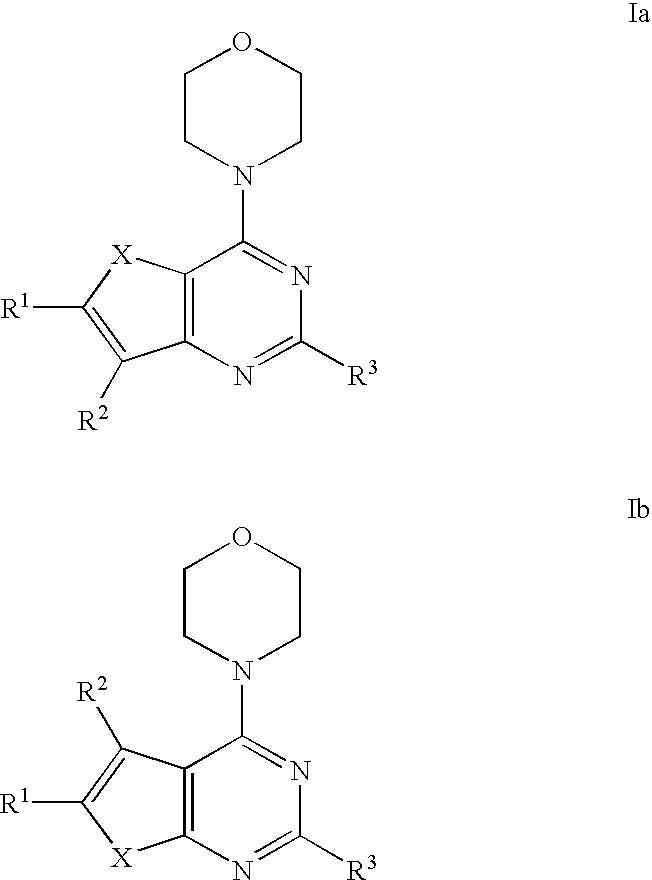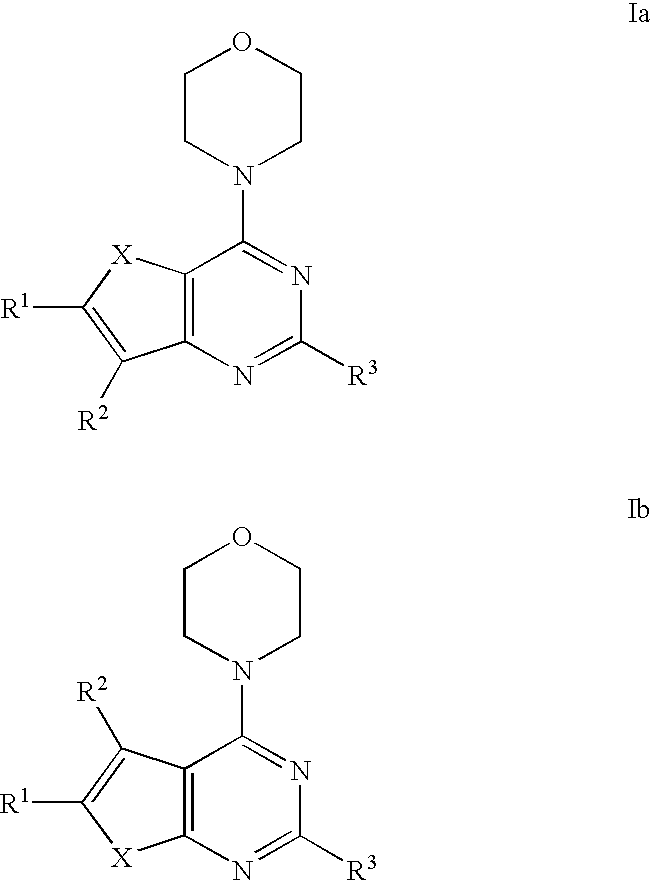Phosphoinositide 3-kinase inhibitor compounds and methods of use
- Summary
- Abstract
- Description
- Claims
- Application Information
AI Technical Summary
Benefits of technology
Problems solved by technology
Method used
Image
Examples
example 1
2,4-Dichloro-thieno[3,2-d]pyrimidine 3
[0242]
[0243] A mixture of methyl 3-amino-2-thiophenecarboxylate 1 (13.48 g, 85.85 mmol) and urea (29.75 g, 5 eq.) was heated at 190° C. for 2 hours. The hot reaction mixture was poured onto sodium hydroxide solution and any insoluble material was removed by filtration. The mixture was then acidified (HCl, 2N) to yield 1H-thieno[3,2-d]pyrimidine-2,4-dione 2 as a white precipitate, which was collected by filtration and air dried (9.49 g, 66%). 1H NMR 400 MHz, d6-DMSO) 6.90 (1H, d, J=5.2 Hz), 8.10 (1H, d, J=5.2 Hz), 11.60-11.10 (2H, br s).
[0244] A mixture of 1H-thieno[3,2-d]pyrimidine-2,4-dione 2 (9.49 g, 56.49 mmol) and phosphorous oxychloride (150 mL) was heated at reflux for 6 h. The reaction mixture was then cooled and poured onto ice / water with vigorous stirring yielding a precipitate. The mixture was then filtered to yield 2,4-dichloro-thieno[3,2-d]pyrimidine 3 as a white solid (8.68 g, 75%). 1H NMR. (400 MHz, CDCl3) 7.56 (1H, d, J=5.5 Hz), ...
example 2
2-Chloro-4-morpholin-4-yl-thieno[3,2-d]pyrimidine 4
[0245]
[0246] A mixture of 2,4-dichloro-thieno[3,2-d]pyrimidine 3, (8.68 g, 42.34 mmol), morpholine (8.11 mL, 2.2 eq.) and MeOH (150 mL) was stirred at room temperature for 1 h. The reaction mixture was then filtered, washed with water and MeOH, to yield 2-chloro-4-morpholin-4-yl-thieno[3,2-d]pyrimidine 4 as a white solid (11.04 g, 100%). 1H NMR (400 MHz, d6-DMSO) 3.74 (4H, t, J=4.9 Hz), 3.90 (4H, t, J=4.9 Hz), 7.40 (1H, d, J=5.6 Hz), 8.30 (1H, d, J=5.6 Hz).
example 3
2-Chloro-4-morpholin-4-yl-thieno[3,2-d]pyrimidine-6-carbaldehyde 10
[0247]
[0248] To a suspension of 2-chloro-4-morpholin-4-yl-thieno[3,2-d]pyrimidine 4 (1.75 g, 6.85 mmol) in dry THF (40 mL) at −78° C. was added a 2.5M solution of n-butyllithium (nBuLi) in hexane (3.3 mL, 1.2 eq.). After stirring for 1 h, dry DMF (796 μL, 1.5 eq.) was added. The reaction mixture was stirred for 1 h at −78° C. and then warmed slowly to room temperature. After a further 2 h at room temperature the reaction mixture poured onto ice / water yielding a yellow precipitate. This was collected by filtration and air-dried to yield 2-chloro-4-morpholin-4-yl-thieno[3,2-d]pyrimidine-6-carbaldehyde 10 (1.50 g, 77%). 1H NMR (400 MHz, d6-DMSO) 3.76 (4H, t, J=4.9), 3.95 (4H, t, J=4.9), 8.28 (1H, s), 10.20 (1H, s).
[0249] Also, to a suspension of 4-(2-chlorothieno[2,3-d]pyrimidin-4-yl)morpholine (1.75 g, 6.85 mmol) in dry THF at −78° C. was added a 2.5M solution of n-butyllithium (nBuLi) in hexane (3.3 mL, 1.2 eq.). Af...
PUM
| Property | Measurement | Unit |
|---|---|---|
| Angle | aaaaa | aaaaa |
| Energy | aaaaa | aaaaa |
| Composition | aaaaa | aaaaa |
Abstract
Description
Claims
Application Information
 Login to View More
Login to View More - R&D
- Intellectual Property
- Life Sciences
- Materials
- Tech Scout
- Unparalleled Data Quality
- Higher Quality Content
- 60% Fewer Hallucinations
Browse by: Latest US Patents, China's latest patents, Technical Efficacy Thesaurus, Application Domain, Technology Topic, Popular Technical Reports.
© 2025 PatSnap. All rights reserved.Legal|Privacy policy|Modern Slavery Act Transparency Statement|Sitemap|About US| Contact US: help@patsnap.com



